The Monasteries of Mount Athos are occupied predominantly by Greeks, but also brotherhoods of Georgian, Bulgarian, Russian, Romanian, and Serbian monks.
Mount Athos, also known as the Holy Mountain is an autonomous republic of Eastern Orthodox monks situated at the easternmost peninsula of the Halkidiki in northeastern Greece. In Greek, Mount Athos is called “Agio Oros” which refers to the 2033-meter mountain the Holy Mountain is honored by Eastern Orthodox Christians as a holy land and place of pilgrimage.
The Mount Athos monastic world begins where Ouranoupoli town ends, it’s an autonomous and self governing part of Greece and owns a land of about 330sq/km. The borders of Mount Athos is 3km Southern from the town of Ouranoupoli.
If you are not able of visiting Mount Athos, you can exlpore the old Byzantine tower prosforion in the central square of the town or you can visit the unique Zygou monastery monument which is accessible by anyone who wants to discover how a monastery of Mount Athos building is like from the inside.
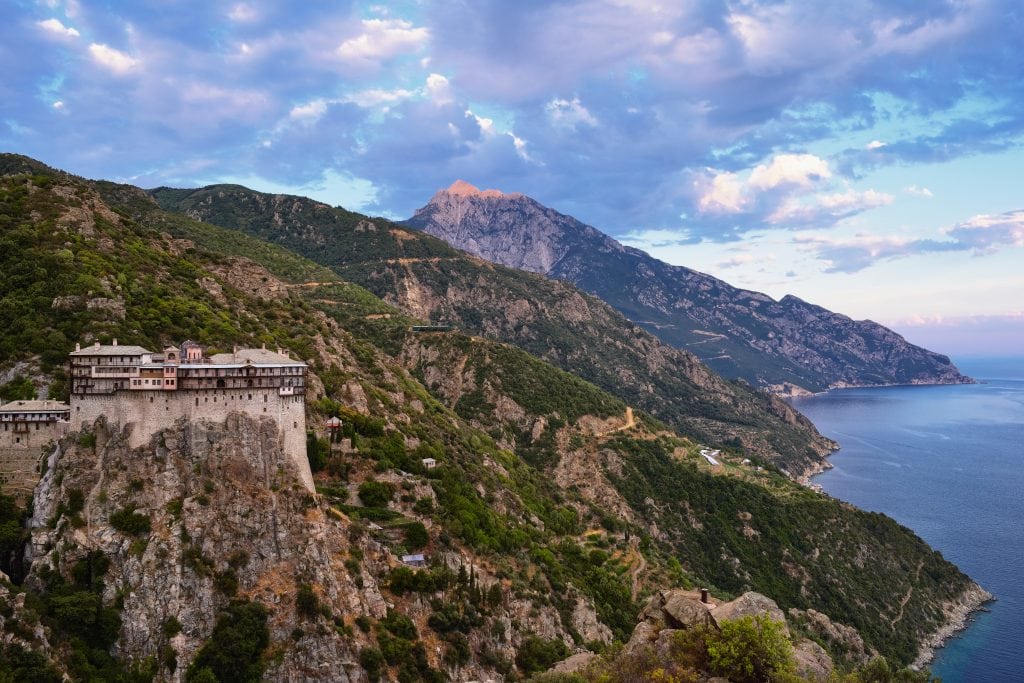
Table of Contents
The monasteries of Mount Athos
As early as the seventeenth century, the Athonite peninsula, depopulated from the classical ages was settled by hermits. The byzantine emperor recognized Athos as a territory for male hermit monks in 885, banishing from the territory all resident layman and shepherds as well as women and female domestic animals.
Cloaked by beautiful chestnut and other type of Mediterranean forest, the steep slopes of Mount Athos are punctuated by twenty imposing monasteries of Mount Athos and their subsidiary establishments farming constitutes an important part of the monk’s everyday life.
There are 20 monasteries of Mount Athos, most of them are Greek, there is one Russian, a Serbian and a Bulgarian one. By joining a guided Halkidiki cruise to the west side of the peninsula you will be able to explore the eight monasteries of Mount Athos.
There are nine monasteries of Mount Athos on the Eastern part and three more among the mountains and close to Karyes, which is the center of Mount Athos, there you can find the church of ”Protatos”, the building of the Holy Community and the nineteen “Konakia” of Monasteries.
A boat tour to the West part of Athos peninsula
Every summer season there are daily boat departures from Ammoulianis island, Ouranoupoli port and Ormos Panagias on Sithonia peninsula, to the west part of Athos. By joining a boat tour you will be guided on the following monasteries of Mount Athos:
- Dochiariou,
- Xenofontos,
- Saint Panteleimonos,
- Xiropotamou,
- Simonos Petras,
- Grigoriou,
- Dionisiou
- Saint Paul monastery
also you will be able to see the central port of Mount Athos Dafni, the Mountain Athos which is 2033m high and the Nea Skiti and the Skiti of Agia Anna.
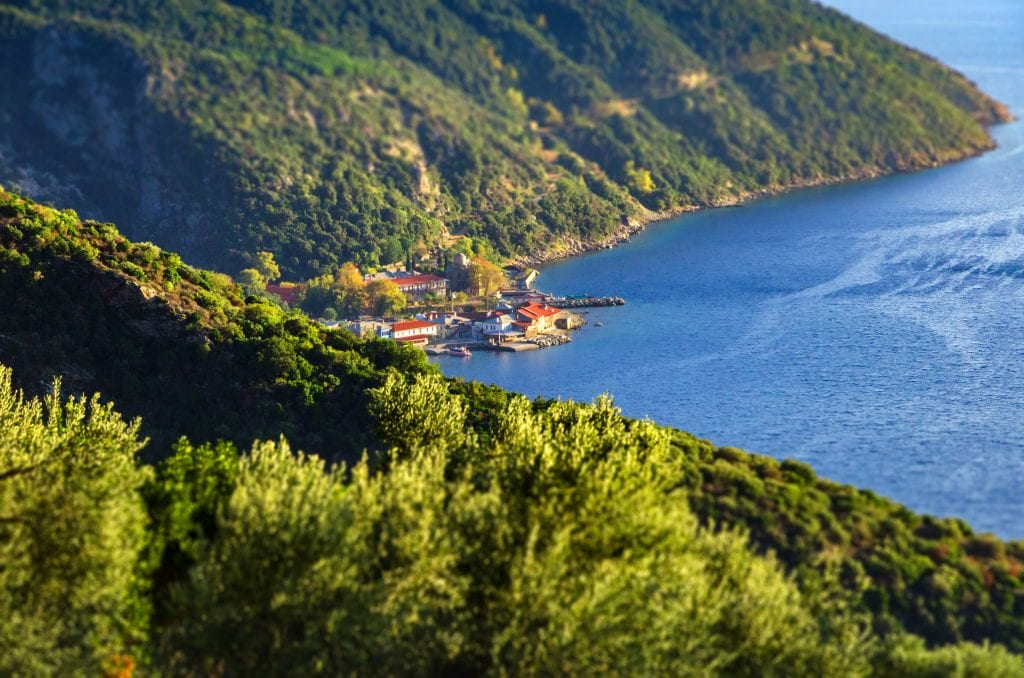
In this part of the article we will explore the monasteries of Mount Athos on the west side of the peninsula.
Dochiariou Monastery
It’s a coenobitic monastery of Mount Athos founded in the 10th century, the katholikon is dedicated to archangel Michael and Gabriel. In the library are kept about 3000 printed books and several manuscript. This monastery owns the most respected icon in the Holy mountain, the icon of the Virgin which is caracterized as miraculous
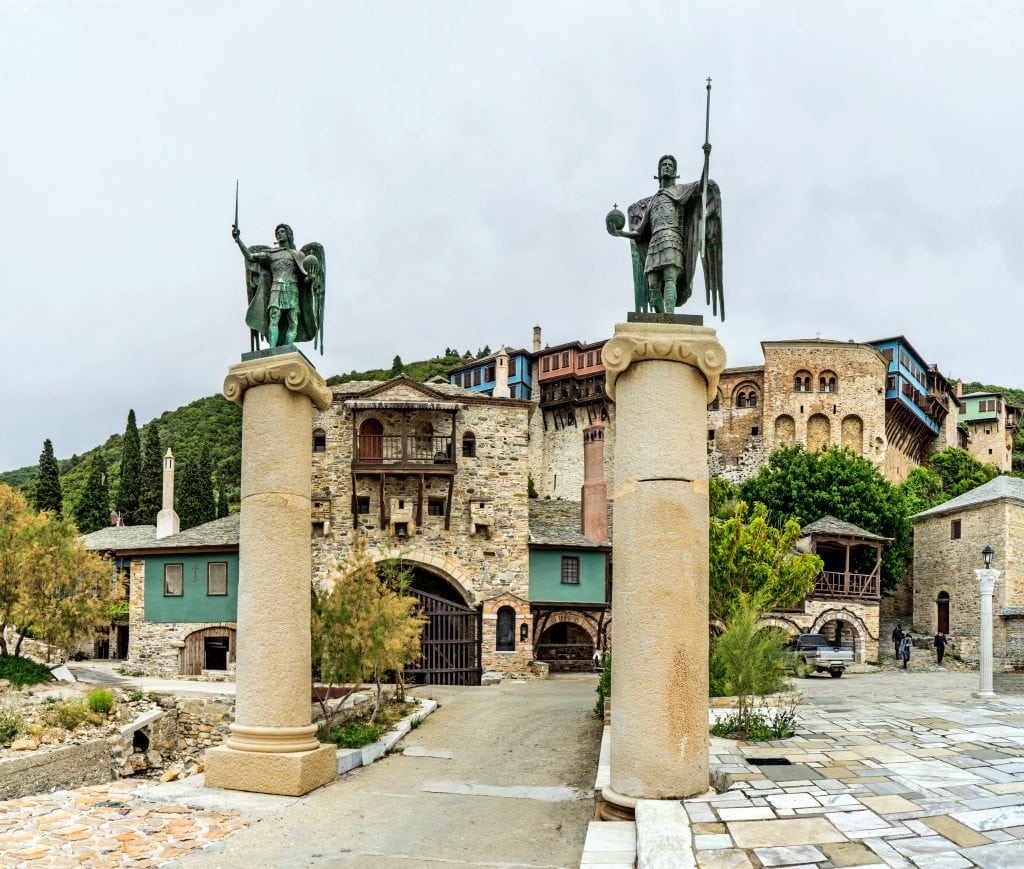
Xenofontos Monastery
It’s a coenobitic monastery of Mount Athos built in 998, one katholikon is dedicated to Saint George and a second and smaller one is dedicated to Saint Dimitrios. Among the treasures are two beautiful mosaic icons from 13th century, an icon of Virgin Mary represanting the metamorphosy, and another icon of the Virgin which caracterized as miraculous. In the library are kept, 4000 printed books, 300 manuscript and documents, 50 monks live here today.
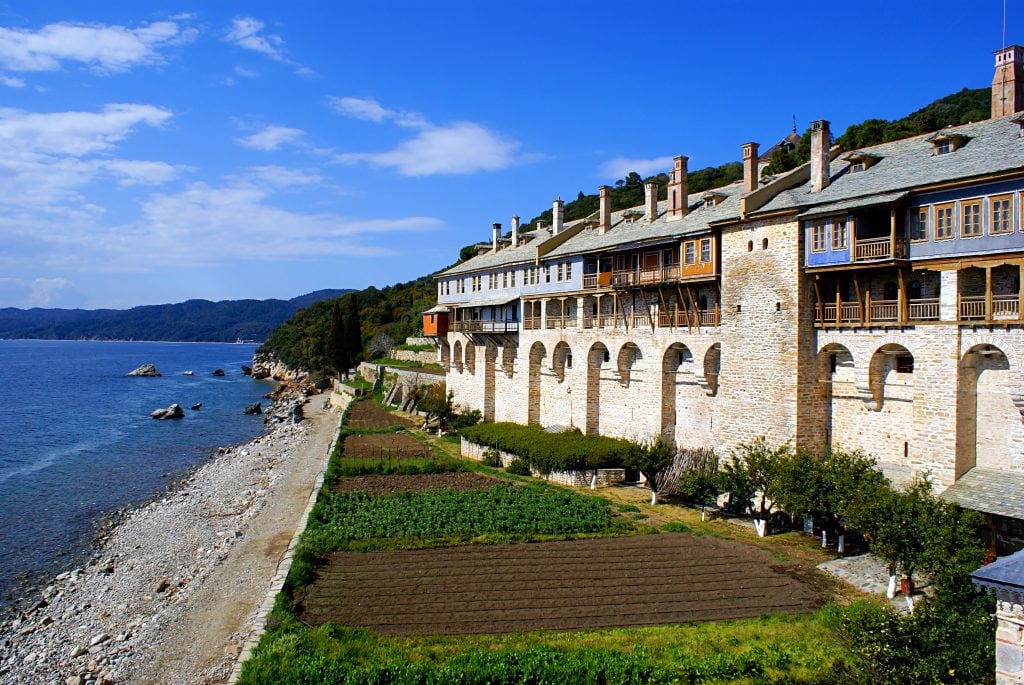
Saint Panteleimonos Monastery
Has as well the title the monastery of the Russians, as since the foundation Russian monks still live here. The construction of the present monastery, begun about 1800 and it was finished in 1865. At the end of the 19th century, it’s supported about 2000 monks. Today about 60 monk Greek and Russians, live here. The main katholikon is dedicated to Saint Panteleimon, next to this katholikon and in the Northern part of the monastery, exists the famous church of Saint Skepi and of Alexander Nevski, which is entirely decorated in gold.
Here we find the second biggest bell on earth after that in Saint Petersburg which weights 13tons, together with 32 smaller ones. Famous treasures are portable icons of Saint Panteleimonos and of the Virgin. The library contains 1920 Greek and Russian manuscripts and about 20000 printed books.
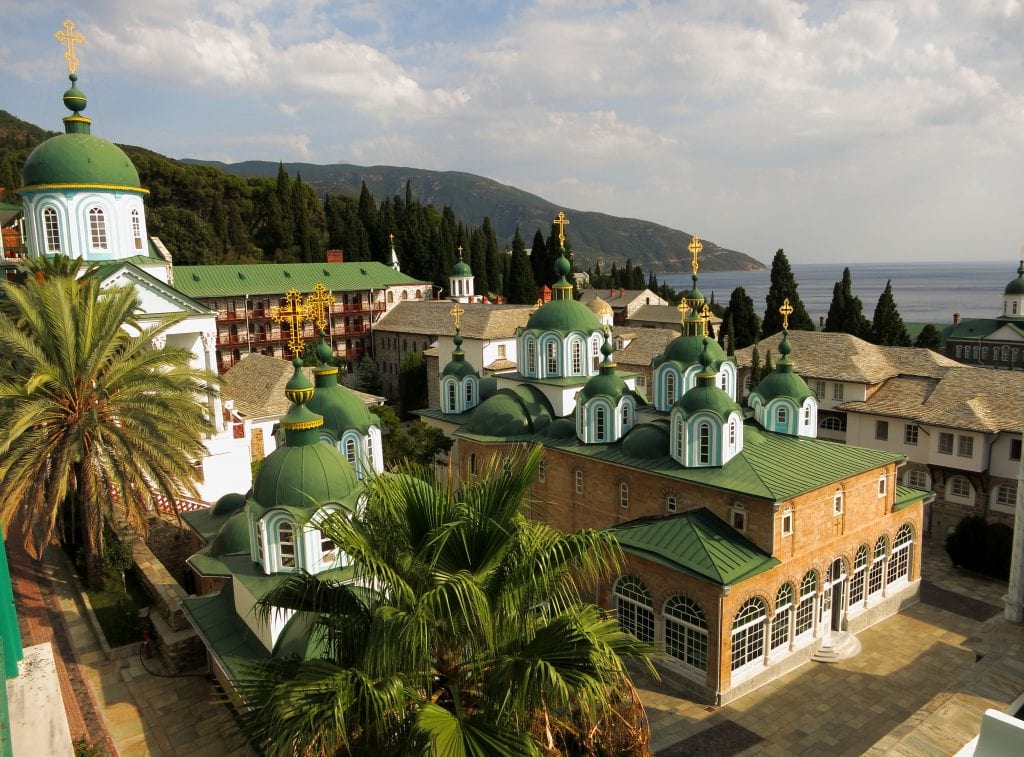
Xiropotamou Monastery
It’s a coenobitic monastery of Mount Athos built in the 11th century propably by the monk Paul Xiropotaminos and this monk gave his name to the monastery. The katholikon is dedicated to forty martyrs. Magnificent treasures are kept, the most famous is perhaps the largest known fragment of the true Cross, in this fragment one of the holes left by the nails is visible, this part is fully coverd with diamonds, further more are kept part of the clothes which covered Christ and part of the crown of thorns. In the library are kept 4000 books 400 manuscripts and in total 38 monks live here.
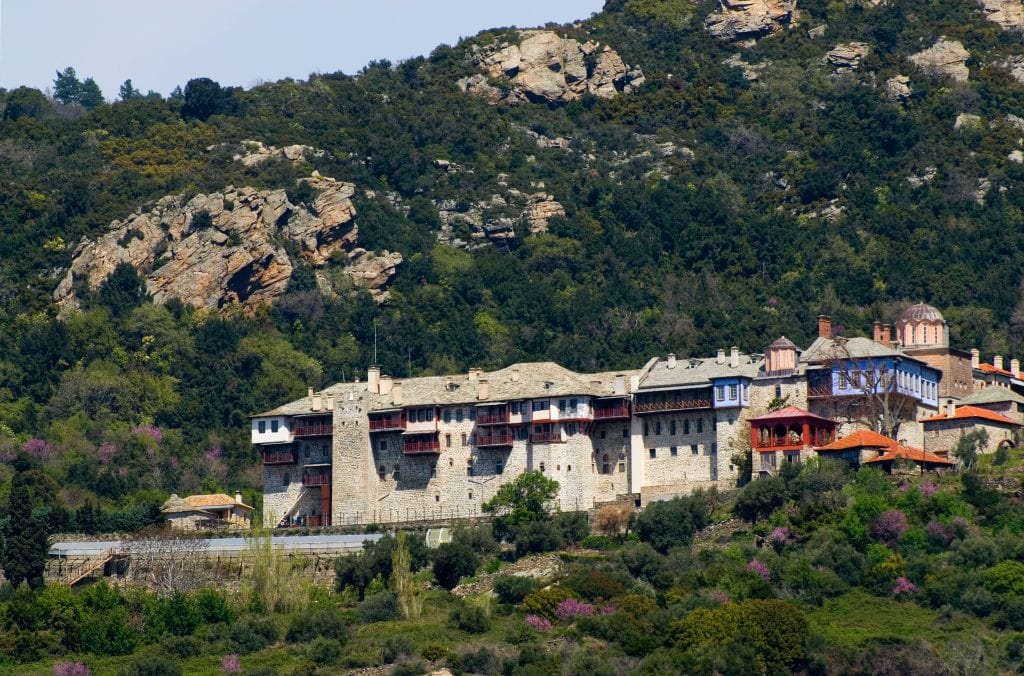
Central port Dafni
The central port of the Holy Mountain, here arrives the passenger boats which carry monks and the male visitors who already have the permission of visiting the monasteries of Mount Athos. From here the visitors start by themselves, either with a bus or on foot to reach the monastery they want to visit. In Dafni exists, restaurant, a small pansion, three small mini markets, the police, post office, port police and the custom control. No monks are living in Dafni but only civilians who are working and living here.
Simonos Petras Monastery
One of the most impresive building on the Mount Athos area, It’s a cinobitic monastery of Mount Athos built in 12th century from Saint Simon, on a rocky place 250m over the sea, this seven stored monastery was destroyed by fire in 1891 and nearly all it treasures were lost, so that in the library are kept only 1500 printed books, in this monastery 60 monks live today.
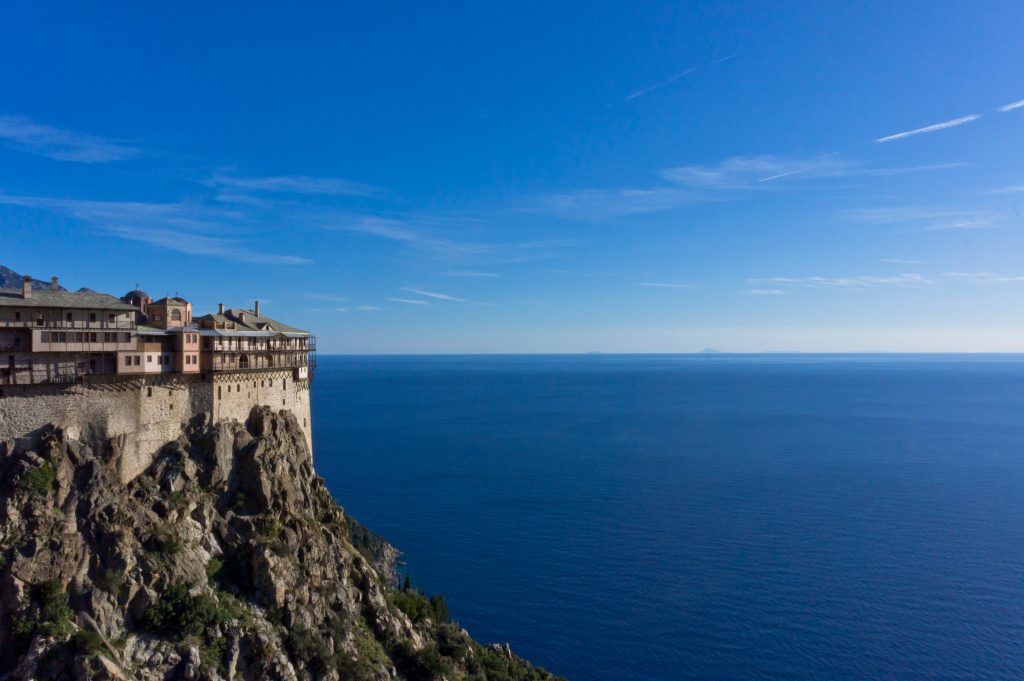
Grigoriou Monastery
It’s a coenobitic monastery of Mount Athos founded in the 14th century. The katholikon is dedicated to Saint Nikolas, it is one of the most inhabited monasteries in Mount Athos, about 100 monks live here today. It is well know because of it’s achievements in missionary. Among the treasures are kept 2 beautiful icons of the Virgin and in the library is kept the unique manuscript of Hermas. This manuscript belongs to the apocryphal books of the Gospel.
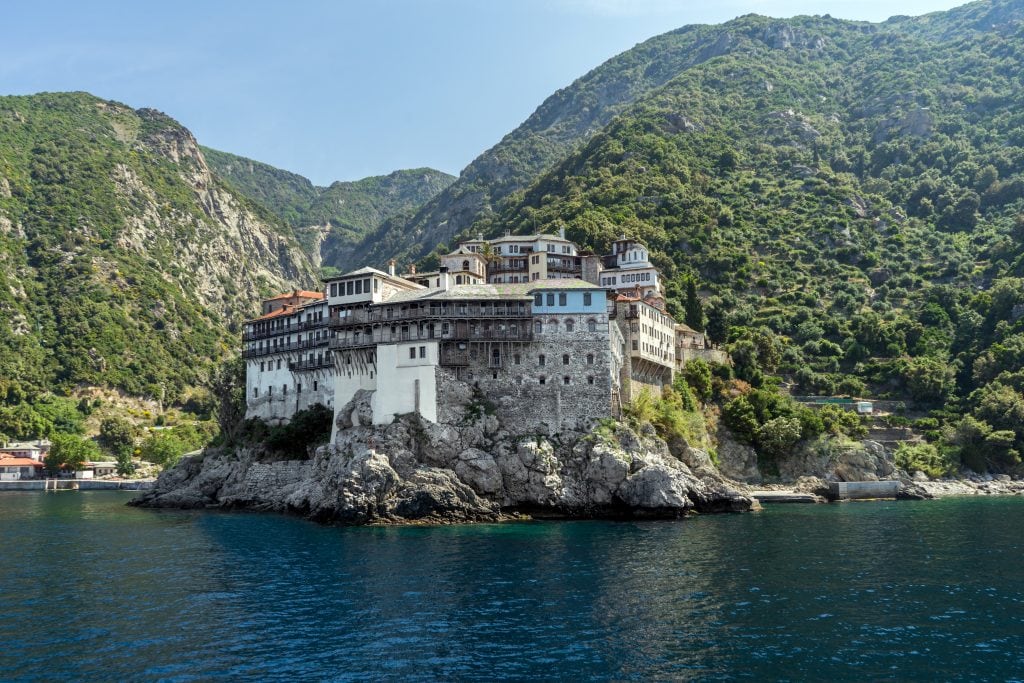
Dionisiou Monastery
Is built on rocky side 80m over the sea, founded in the 14th century by Saint Dionisios. In the church there is a fine carved wooden iconostasis with rich decoration. Further is kept an unusual icon of the Virgin, made of wax and rubber. In the library we find 5000 printed books and 800 manuscripts. 45 monks are living here today.
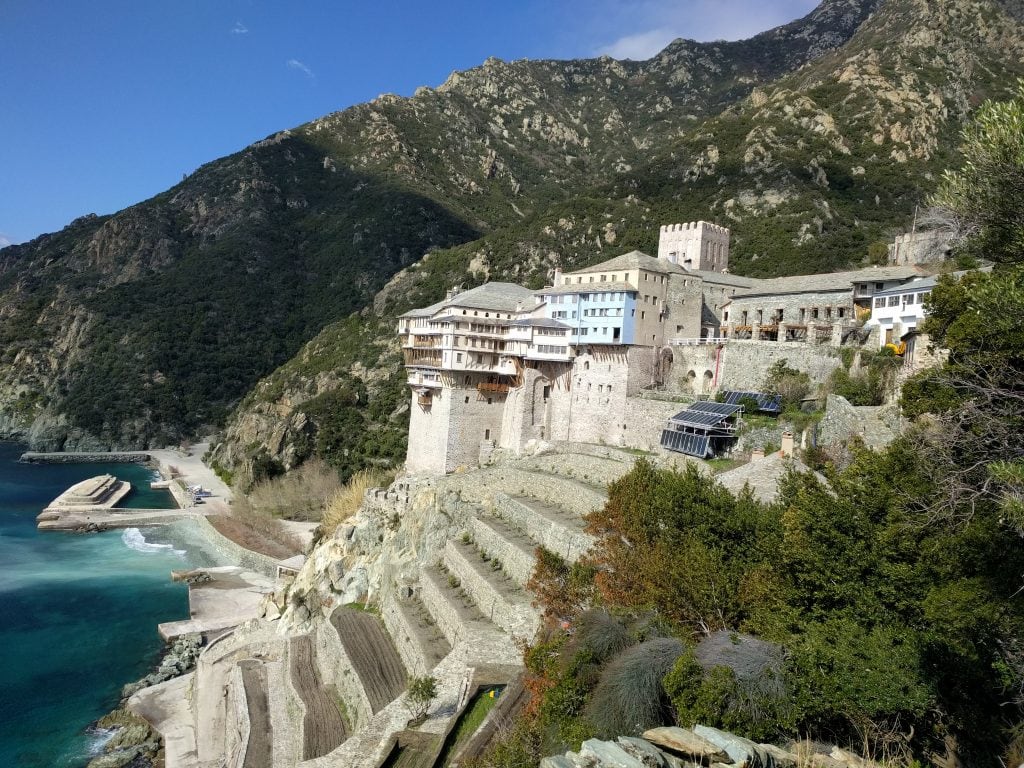
Saint Paul Monastery
Founded by Paul Xiropotaminos, in the 10th century a famous monk during that time who also built the monastery of Xiropotamou. In the church a beautiful iconostasis made of marble is in very good condition today. Serbian rulers donated land money and gift to the monastery. In the library are saved 12500 printed books. Today about 35 monks live here.
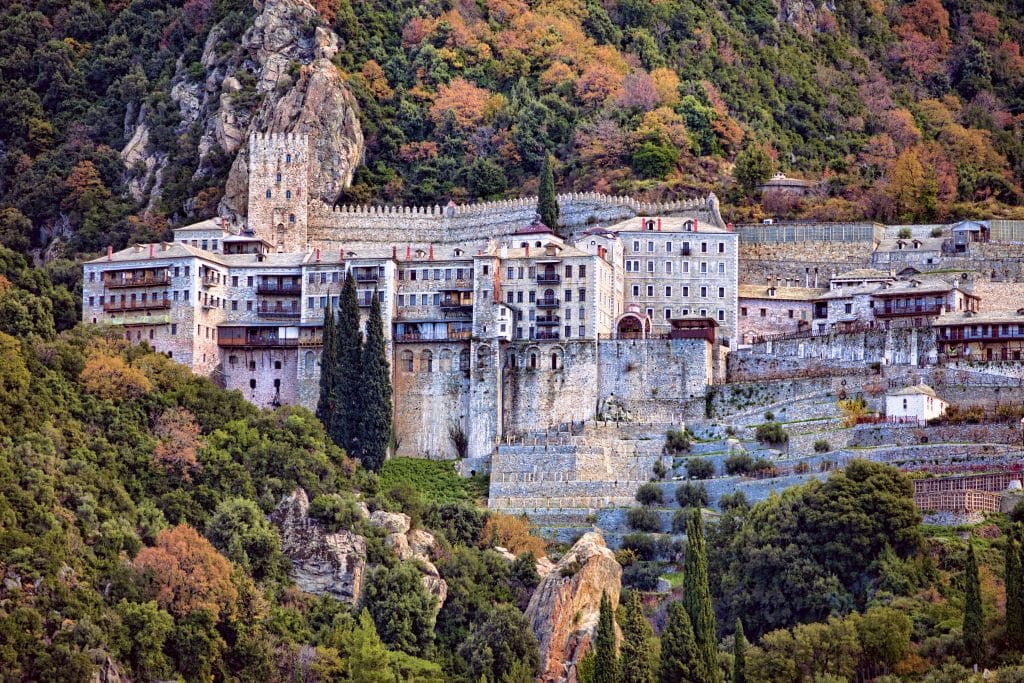
The East part of Mount Athos
Unfortunately there are no any Halkidiki cruises you can join to explore the east’s part monasteries of Mount Athos, The reason is that the sea is always wavy and not so suitable for cruises. Anyway in this part of our article we will write some informations about the East’s side monasteries of Mount Athos.
Esphigmenou Monastery
Founded in the 10th century, the monastery’s name in Greek means tightened. Among the treasures there is a large part of Napoleon Bonaparte’s tent and the Cross of Pulcheria lies at the catholicon’s altar. In the library we find 372 manuscripts and 8000 printed books, 60 monk are living here today.
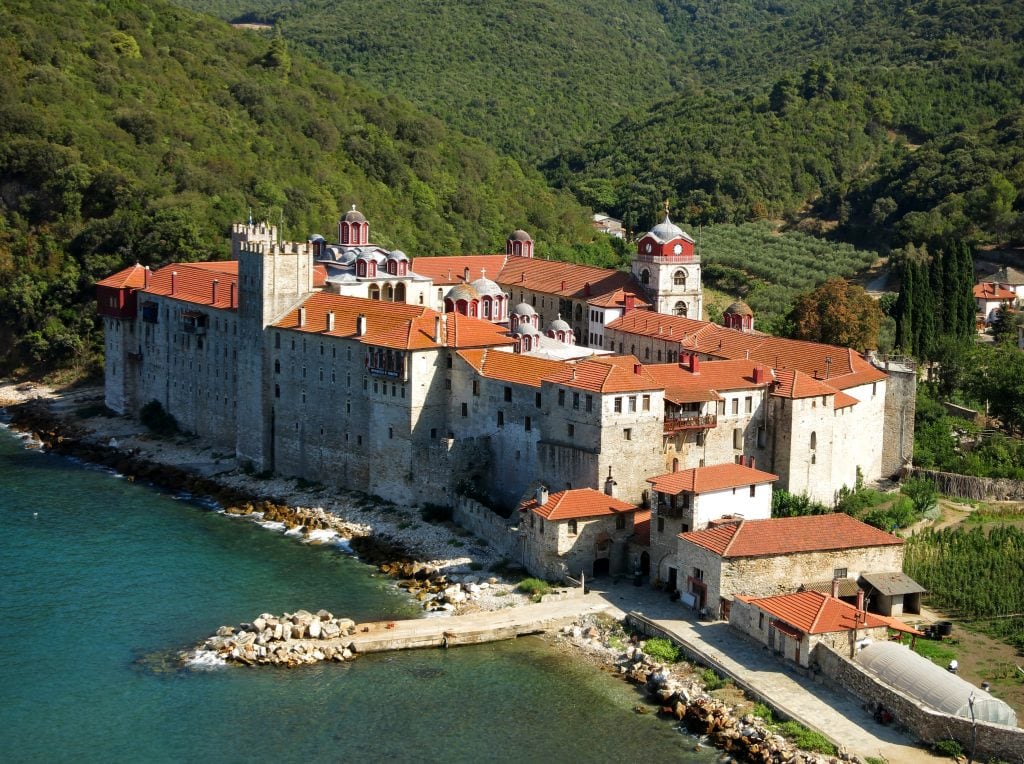
Vatopediou Monastery
Founded around 972-985. The katholikon is dedicated to the Annunciation of the Blessed Virgin, and was built in the 10th century. Some great treasures kept as the Girdle of the Theotokos, the ‘Jasper’ cup and a number of miraculous icons of Virgin Mary, such as, the Ktetorissa, the Esphagmeni, the Elaiovrytissa and the Paramythia adorn the monastery. The library contains about 2000 manuscripts and 35000 printed books. In this monastery are living about 50 monks today.
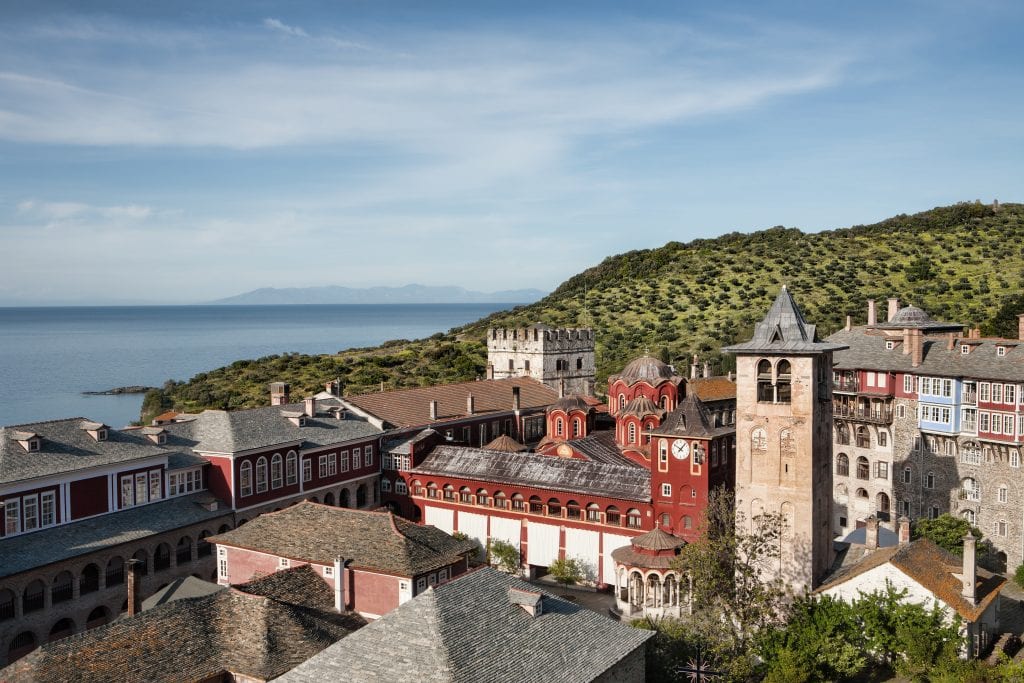
Pantokratoros Monastery
A coenobitic monastery of Mount Athos founded before 1358. The katholikon is dedicated to the Transfiguration of the Saviour. Some treasures the monastery keeps is a piece of the True Cross, a part of the shield of St Mercurius and the miraculous icon of Virgin Mary the Gerontissa. The library contains 350 manuscripts and 3500 pinted books.
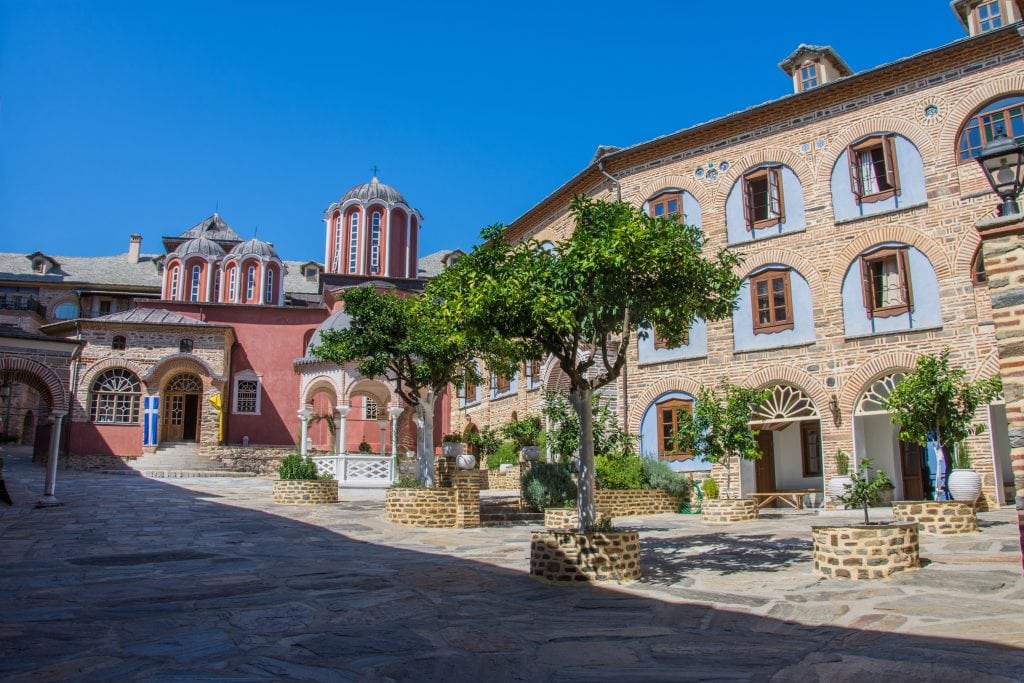
Stavronikita Monastery
It is a coenobitic Monastery of Mount Athos, built around the 10th century. Stavronikita is the smallest among the monasteries of Mount Athos. It’s church is dedicated to St Nicholas. Among it’s treasures we find the icon of St Nicholas known as ‘Streidas’, the library contains a large amount of printed books and 171 manuscripts. In the monastery about 30 monks are living here today.
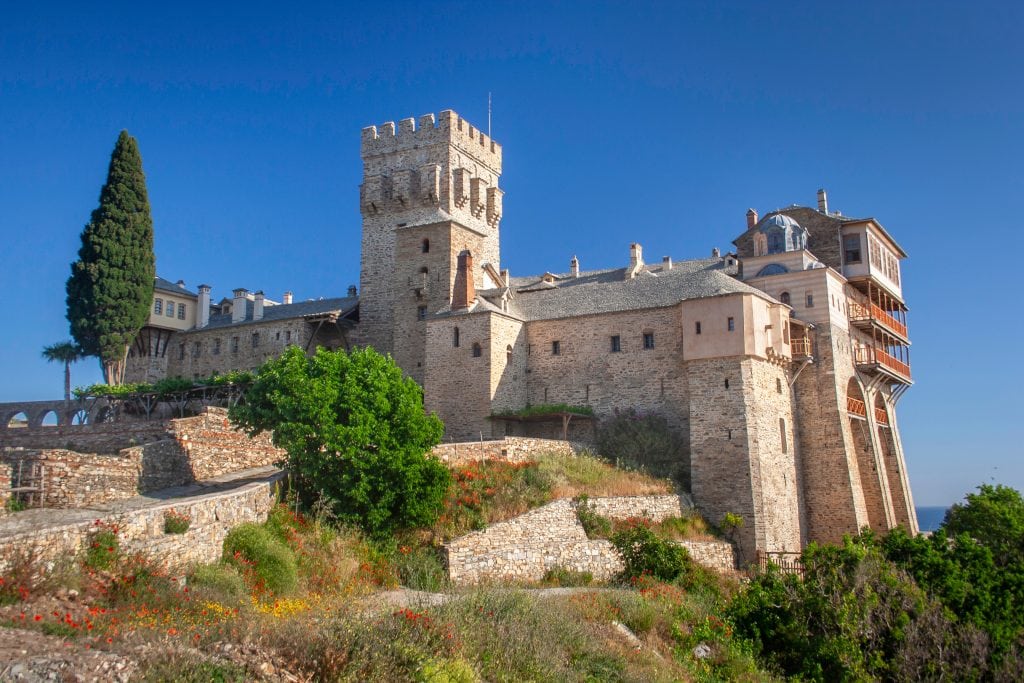
Iviron Monastery
A coenobium monastery of Mount Athos, built in the end of the 10th century by St John the Iberian. In the 14th century it suffered damages from pirates but it managed to recover with some help from the princes of Goergia, Serbia and Palaeologues also in it’s history it almost burned down to ashes two times The katholikon is dedicated to the Dormition of the Theotokos. Some known great treasures are a Gospel book which is a gift of Peter the Great, the relics of at least 150 Saints and the Holy Mountain’s protecting icon – that of Our Lady Portaitissa. In the library we find 20000 printed books and 2000 manuscripts.
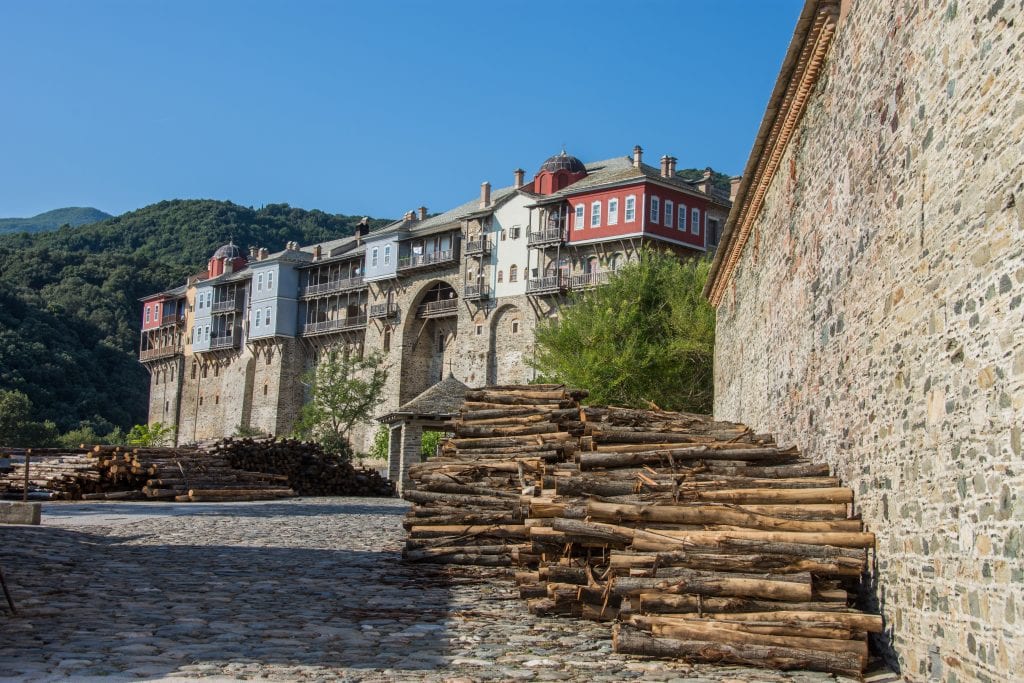
Filotheou Monastery
It is a coenobitic Monastery of Mount Athos founded by the Blessed Philotheus around the end of the 10th century. The Monastery owns the great and miraculous icon of Virgin Mary the Glykophilousa and of Virgin Mary the Gerontissa. Among it’s treasures are kept a piece of the true Cross, relics of Saints and the pride of place goes to the right hand of St John Chrysostom. In the library we find 250 manuscripts and 2500 printed books. In the monastery today are living about 60 monks.
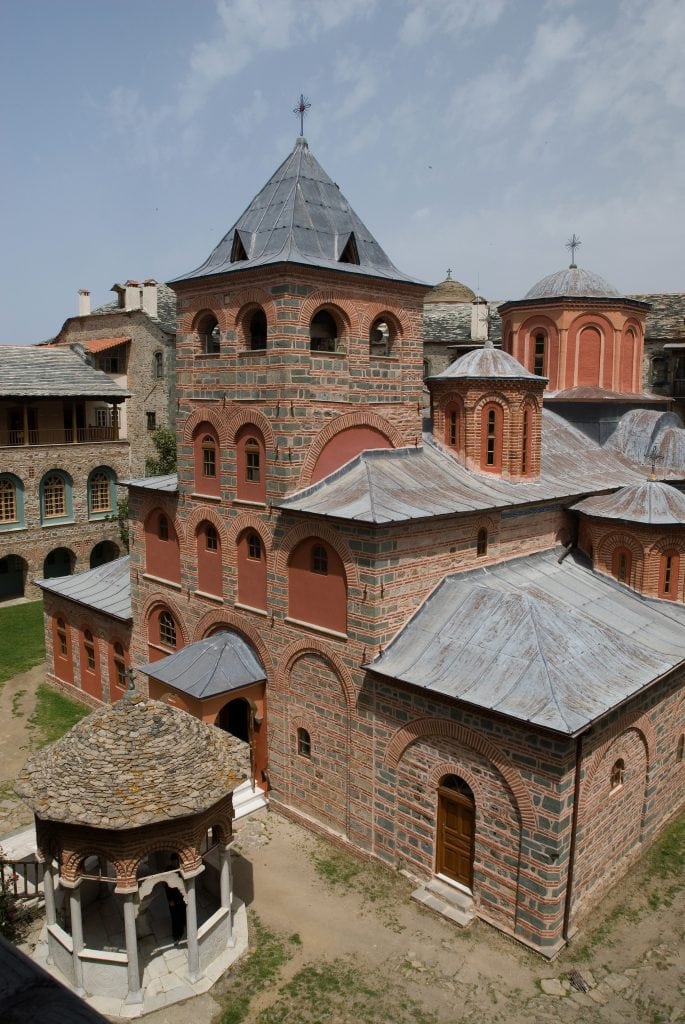
Karakalou Monastery
Founded by a monk named Karakalas around the 11th century. It’s Katholikon is dedicated to Sts Paul and Peter. In the 13th century the monastery was deserted after pirate raids but soon the Palaeologue Emperors brought it back to life. Karakalou is keeping the 11th place among the monasteries of Mount Athos. Among it’s treasures we find the skull of St Christopher and the Apostle Bartholomew, also they kept a fragment of the true Cross. In the library there are 279 manuscripts and 2500 printed books. 30 monks are living here today.
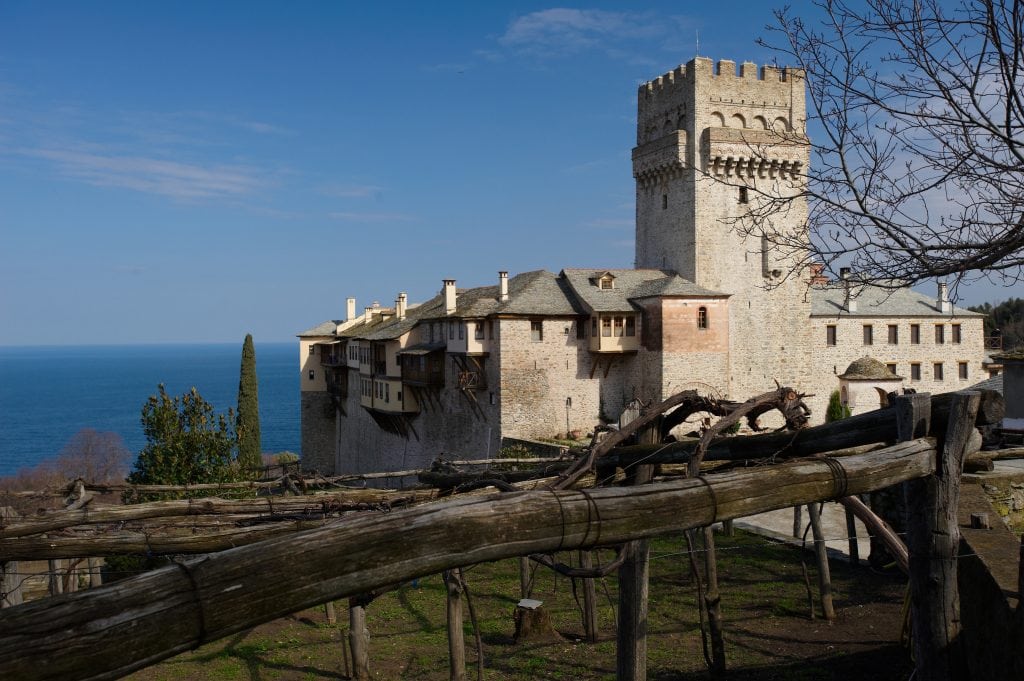
The Great Lavra Monastery
Built around 963 by St Athanasius the Athonite, the church was dedicated to the Annunciation of the Blessed Virgin and outside the katholikon we can find the largest phiale for holywater among the monasteries of Mount Athos. Some great treasures are the icon of Virgin Mary the Koukouzelissa, sacred relics and patriarchal and imperial dalmatics. In the library there are 20000 printed books, 2116 manuscripts and 100 manuscripts in foreign languages. There around 50 monks living here today.
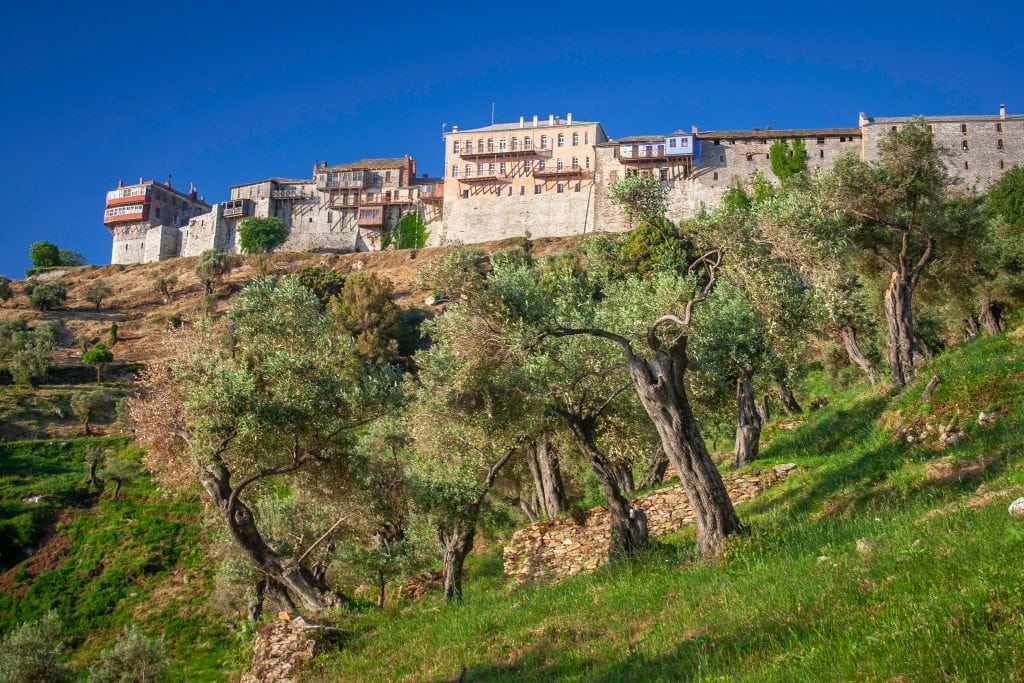
The Monasteries among the mountains
Among the mountains there are 3 more Holy Monasteries of Mount Athos we can’t see while we are traveling throug the sea, these are:
- the Koutloumousiou Monastery which is next to Karyes
- the Zographou Monastery which is in the Southern part of the peninsula
- the Monastery of Hilandar which is next to Esphigmenou Monastery
Koutloumousiou Monastery
Propably founded around 1100 by monk Kallistos from the garden of Koutloumous. It’s katholikon dates from the 16th century. Among it’s treasures there are many relics of Saints, interesting portable icons and vestments. In the library we find 6500 printed books and 662 manuscripts. Koutloumousi is in the sixth place of the monasteries of Mount Athos. 20 monks are living here today.
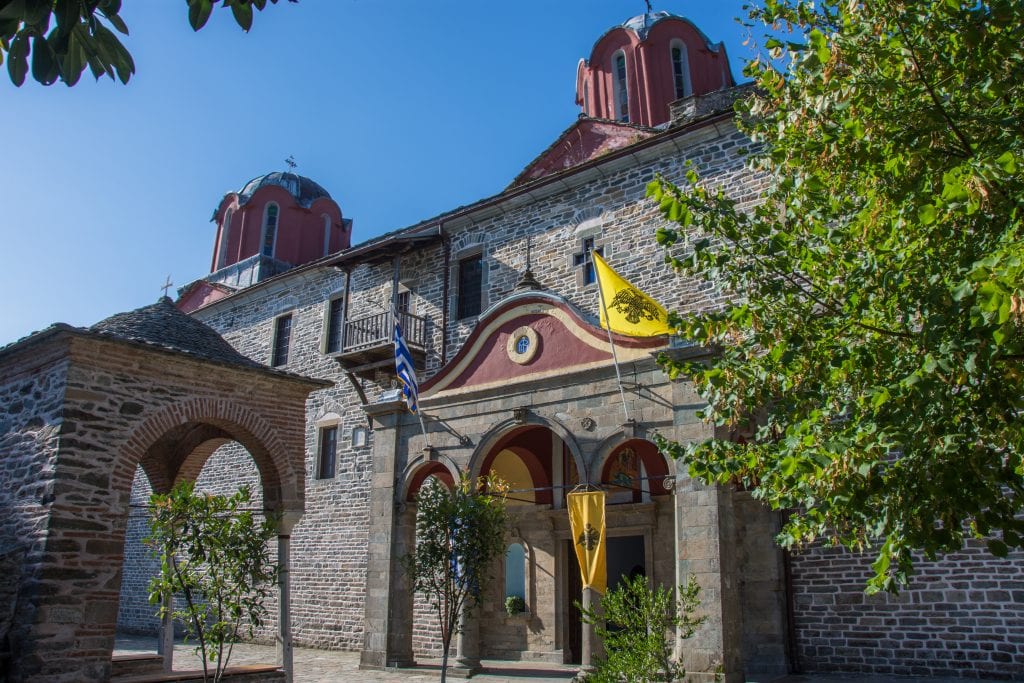
Zographou Monastery
The Bulgarian monastery of Mount Athos, founded by the monks Aaron, John and Moses. According to another source the founder was Georgios Zographos who signed Tsimiski’s Typicon around 972. It’s dedicated to Saint George, , of whom it preserves an old icon, not painted by human hand, which is one of its most valued treasures, also there are two miraculous icons of Virgin Mary of the Akathistos Hymn and the Virgin Mary the Epakouousa. In the library we find 126 Greek and 388 Slavic manuscripts, also 10000 printed books. In the monastery today they are living 15 monks.
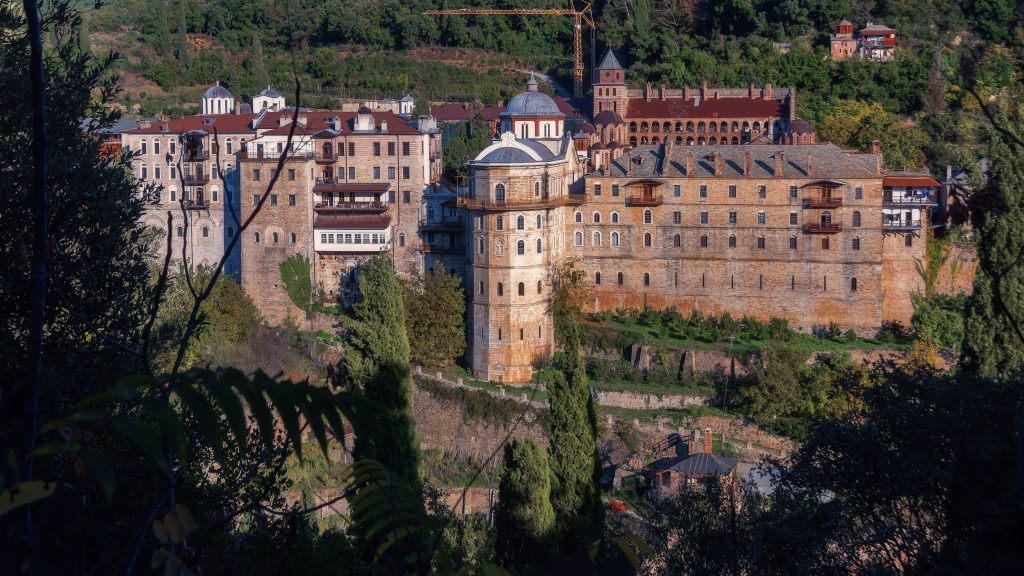
Hilandar Monastery
Found by Stefan Nemanja in the 12th century. The katholikon is dedicated to the Presentation in the Temple of the Blessed Virgin Mary. Some great treasures are the coffin chest of Saint Symeon and it’s vine, the fruit grape which cured many women of sterility and the miraculous icons of Virgin Mary the Tricherousa, two crosses made of wood by a piece of wood from the true Cross and the reed and the shroud from the Passion of Christ. In the library there are 181 Greek and 809 Slavic manuscripts and 20000 printed books. 22 monks are living here today.
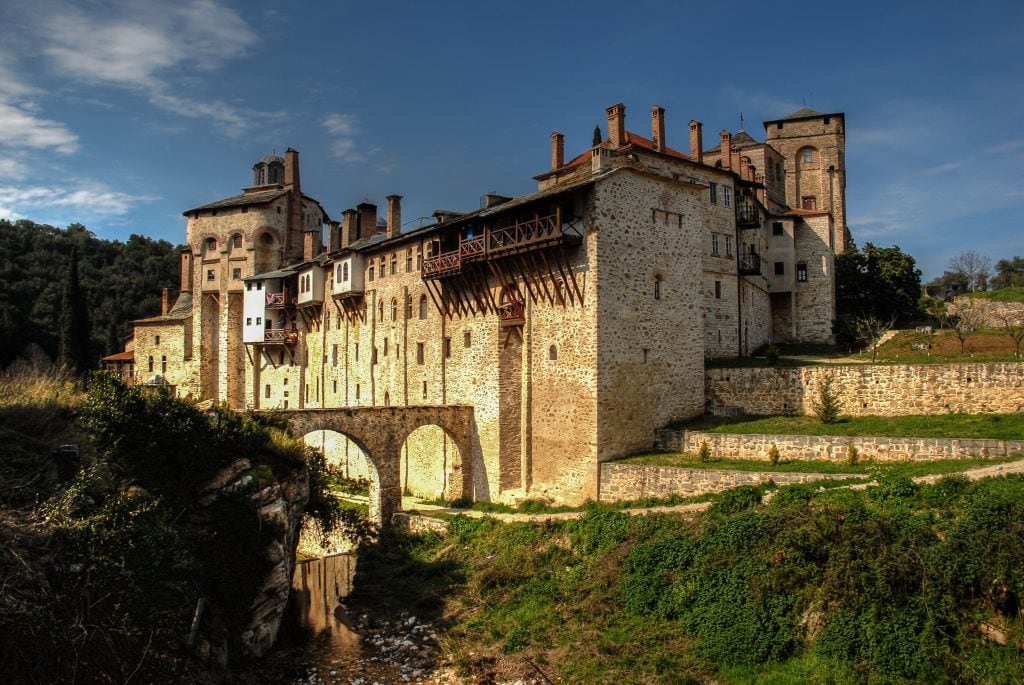
Monasteries of Mount Athos Map
You can use this google map to locate all the Monasteries of Mount Athos, this would be usefull if you are planing to travel in the monastic world or if you will join a Halkidiki cruise to Mount Athos.
FAQs
You Ask, We Answer
I want to join a cruise along the west coast of Mount Athos, what’s the procedure?
You can visit our official website, as you will find the product you are interested for, there will be more details and information about it. You can buy your tickets online or you can reserve some seats by a phone call. The most famous cruise to explore the monasteries of Mount Athos is the cruise 1
Are women allowed to visit the Mount Athos area?
Women are not allowed to visit Mount Athos, according to the tradition Virgin Mary blessed it and asked her Son to be her garden. A voice was heard saying: “Let this place be your heritage and your garden, a paradise and refuge of salvation for those who want to be saved. From that moment the mountain was dedicated to the Virgin Mary or the Mother of God (Orchard of the Virgin Mary) and entry was forbidden for all other women.
How can I visit Mount Athos?
You need to contact with the pilgrims office in Thessaloniki or Ouranoupoli, they will ask you to post them a copy of your passport, two weeks before the date you asked to visit Mount Athos you have to call and ask if your demand is approved.
Did you find our post helpful?
- Was this post helpfull?
- Rate us on TripAdvisor
This article made by https://lnk.bio/Rodokalakis
